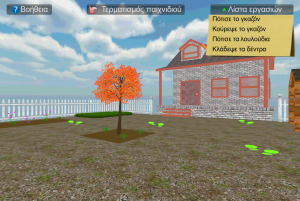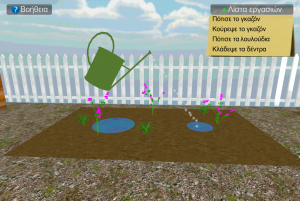
Do you like gardening? The Virtual Garden game is based on the simulation of this activity! In the virtual environment of the game, the user can choose tools and perform basic actions such as plant removal, pest eradication, watering. The Virtual Garden is aimed at training a multitude of cognitive dimensions, but mainly memory, praxis, executive function and orientation. This application runs on PC and tablet devices and there is also a web-based version.
Basic information
Definition:
The Virtual Garden (VG) application is based on the simulation of a common everyday activity, namely gardening. The user has to select the appropriate tool in order to perform a series of gardening-related tasks that appear on a list on the screen. The user must perform all listed tasks and then return the tools to the garden shed.

Objectives:
The Virtual Garden aims at improving the patient’s ability to perform a complex daily activity such as gardening. In the virtual environment of the application, the user can choose tools and perform basic actions such as plant removal, pest eradication, watering.
The Virtual Garden is aimed at training a multitude of cognitive dimensions, but mainly memory, praxis, executive function and orientation.
Duration:
Duration depends on the difficulty level. There are 4 levels of difficulty. One session will last between 10-30 min.
Cost:
Free
Reference:
Development
Participants:
Physical requirements: Not high in general.
- For computer games: the ability to use a mouse
- For tablet games: basic functionality of arms and fingers. 10 inch tablets should be used for increased usability.
Dementia level: Healthy old people and people with mild cognitive impairment (MCI).
Education: over 6 years.
Number of participants: Individual only.
Material and requirements:
In general:It doesn’t require any specialized equipment or personnel and at the same time it doesn’t put any strain on the examinee.
Materials: The Virtual Garden application runs on PC and tablet devices and there is also a web-based version.
Environment considerations: quiet room, good lighting conditions (not overly bright or too dark)
Support needed:
Professionals should have a knowledge and understanding of the impact of dementia and give clear instructions to users. Also, they should be patient when introducing the game, and exhibit a positive and encouraging attitude that provides comfort to players. Of course, on occasions and with certain people (depending on their capabilities) it may be necessary to provide more support but it is important for practitioners to be mindful that their aim is to empower people whilst they interact with the game.It is important for practitioners to ensure that the game is set to the easiest level at the beginning as they can always adjust the difficulty as players improve.
Starting point:
Open the initial screen. During the practice session players are allowed to navigate freely and choose the appropriate tool for gardening, in order to train themselves in using the VR interface.It is important to ensure that the game is set to the easiest level.
Development:
Space navigation is done by moving the user to fixed locations in the area marked with green footprints (Figure 2). The player has to touch the green footprints. The user is asked to perform a special activity such as plant removal, pest eradication, watering. For executing this specific work that s/he was asked for, s/he has to select the appropriate tool from the warehouse. After that, s/he has to move to the relevant points of the garden and complete the necessary actions with the tool (e.g. watering pot for flowers – Figure 3). The tool is used by touching the relevant point of the garden e.g. plants that must be watered. After completing all tasks, the user has to return all the tools back to the warehouse.



Additional information
Variants of the game:
It is better to use the game with one participant.
When the participant becomes familiar with the game, there will be less need for assistance.
When you increase the difficulty level, you need more assistance at the beginning of each session.
Virtual gardening has four levels of difficulty.
Alternative games:
Similar AD-GAMING games:
Other related games:
Virtual washing machine:
http://160.40.50.78/ennoisis_laundry/WebPlayer/WebPlayer.html
Assessment:
The application has a data logging subsystem, which gathers results and statistics about the actions and performance of the user, such as what and how many jobs were performed, times of action, off-site tooling, etc.
Practical activity
- Prepare the table, the chair and the PC or the tablet devices
- Open the initial screen of the Virtual Garden
- Professional/family gives a brief explanation
- Start with a practice session. Let the players to navigate freely and choose the appropriate tool for gardening in order to train themselves in using the VR interface
- Ask for any questions/doubts
- Start the game. The game is set to the easiest level at the beginning as you can always adjust the difficulty as players improve
- Continue with higher level of difficulty
- Observe what’s happening, if players need help to follow the instructions, you can guide them.
- Assessment
![]()
